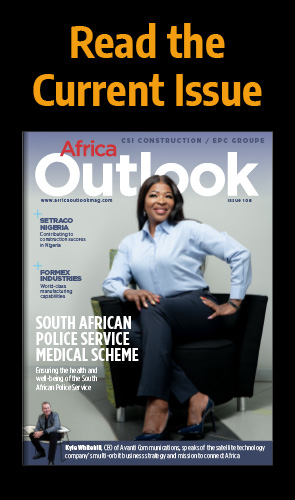
Thusang Mahlangu, CEO of Allianz Global Corporate & Specialty Africa, discusses risks businesses in Africa face in 2020
Writer: Dani Redd
Today’s environment is a volatile one. Not only is the rising tide of coronavirus threatening both businesses and lives, there’s also the fiscal uncertainty of Brexit and the devastation caused by Australia’s bushfires, which decimated over five million square hectares of land. More and more businesses are searching for smart solutions to overcome and manage an increasingly complex series of risks.
Writer: Dani Redd
Today’s environment is a volatile one. Not only is the rising tide of coronavirus threatening both businesses and lives, there’s also the fiscal uncertainty of Brexit and the devastation caused by Australia’s bushfires, which decimated over five million square hectares of land. More and more businesses are searching for smart solutions to overcome and manage an increasingly complex series of risks.
This is where Allianz Global Corporate & Specialty comes in.
AGCS is a business unit of Allianz Group which provides risk consultancy, transfer and insurance solutions across 10 sectors of business, ranging from private individuals to some of the world’s largest consumer brands. It operates in 33 countries, including South Africa.
Thusang Mahlangu is the Chief Executive Officer of Allianz Global Corporate & Specialty (AGCS) Africa – a challenging yet rewarding role he took on in February 2017.
“I first joined AGCS Africa in 2013 as Head of Market Management, focussing on developing sales and distribution across Africa. I subsequently became Head of Property in 2014 and grew the portfolio in key African countries,” the CEO says.
With more than two decades of experience in insurance and risk management, Mahlangu is well-placed to answer our questions. He begins by discussing the Allianz Risk Barometer, an annual survey of thousands of experts across the world, who assess and rank the biggest threats to business.
“The annual survey on global business risks incorporates the views of a record 2,718 experts in over 100 countries including CEOs, risk managers, brokers and insurance experts. Respondents were questioned during October and November 2019,” Mahlangu continues.
“The survey focused on large and small- to mid-sized enterprises. Respondents were asked to select the industry about which they were particularly knowledgeable and to name up to three risks they believed to be of the most importance.”
The final survey featured experts from 22 different industry sectors, and 50 percent of the answers (1,348 respondents) referred to large businesses with a revenue of more than $500 million. Mid-sized enterprises with a $250 million to $500 million revenue contributed 521 respondents (19 percent), while small enterprises with a revenue of $250 million produced 849 respondents (31 percent). Their responses were evaluated to produce a barometer of global risk.
Of course, considering the responses were written at the end of last 2019, nobody could have imagined that COVID-19 was looming on the horizon. However, while the epidemic might not feature by name on the Risk Barometer, it will lead to multiple instances of business interruption – such as workers being unable to access their workplace, disruptions to the supply chain – which is listed as the second top global risk, on a list of 10.
But African companies also face business interruptions unrelated to COVID-19.
“Business interruption, or BI, is an increasing concern for companies as more complex losses continue unabated,” says Mahlangu. “BI also ranks among the top three risks in Tanzania, Nigeria, South Africa and Cameroon.
“Usually driven by property damage, newer triggers like digital platforms and supply chains, political risks and environmental factors are increasing. Contingent business interruption events, or CBI – where a company suffers a loss due to an event at a customer or supplier – are bigger and more far-reaching than they were historically, triggered bynatural catastrophes, fires and cyberattacks.
“Risk trends in the BI space include losses triggered by data vulnerabilities due to technological glitches or cyber-events which could create a chain reaction impacting multiple companies; political risk exposures like riots, civil unrest, strikes and terrorism – whether the business suffers physical damage or not – which can cause huge, costly BI disruptions such as we’ve seen recently in Chile and Hong Kong.
“A third BI trend is physical damage caused by extreme weather around the world, driven by globalisation and supply chain dependencies. Such extreme weather can also wreak havoc in modern food supply chains. Droughts, heatwaves and floods in recent years have impacted yields, including vegetables, wheat and milk, affecting supplies for food manufacturers and retailers.”
The automotive, manufacturing and pharmaceutical sectors are particularly vulnerable to business interruptions, despite highly efficient supply chains, but other industries are also becoming increasingly affected.
However, Mahlangu believes that one positive consequence has emerged from a rise in business interruptions: CBI and BI insurance is becoming increasingly tailored to help protect the assets of individual company, thanks to data-driven insights.
But the greatest risk to businesses – both globally and in Africa – is cyber incidents. These not only include cybercrimes and data breaches, but also IT failure, fines and penalties. The average cost of a cyber incident is on the rise, thanks to more stringent regulations and greater ramifications of data loss upon a business. Affected consumers and business partners are becoming increasingly litigious.
“Trends we are seeing include increasingly larger and more expensive data breaches – so-called ‘mega breaches’ involving over a million records are more frequent and costly; the growing threat of ransomware campaigns; increasing numbers of spoofing or business email compromise,” says Mahlangu.
“Furthermore, political differences being played out in cyber space is also an increasing risk for companies, which are being targeted for intellectual property or by groups intent on causing disruption or physical damage. For example, growing tensions in the Middle East have seen international shipping targeted by spoofing attacks, while oil and gas installations have been hit by cyberattacks and ransomware campaigns.”
Luckily, Mahlangu is just as well-versed in outlining the solution as he is the problem.
“Cyber risks are best mitigated through preparation and training, maintaining secure data back-ups and sound business continuity planning, provided it is regularly tested, practiced and reviewed,” he continues. “Insurance has a vital role to play in helping companies recover if all other measures are insufficient, but it should not replace strategic risk management.
“Investing in employee awareness, together with updating and continuous monitoring of systems should definitely be at the top of any company’s cyber to-do list.”
Another one of the top 10 global risks is climate change, which is a new entrant – according to Mahlangu, its inclusion has been driven by experts in Ghana, South Africa, Tanzania and Cameroon.
They fear an increase in physical losses (such as factories and other corporate assets) thanks to increased flooding, droughts and rising seas. This might lead to the need for relocation, as well as threatening transport and energy links that comprise the supply chain.
Mahlangu believes it is imperative that businesses in Africa and beyond consider the impacts of climate change upon their businesses.
“There is a growing awareness among companies that the negative effects of global warming above two degrees Celsius will have a dramatic impact,” he explains. “Failure to take action will trigger regulatory action and influence decisions from customers, shareholders and business partners.
“Ignoring climate risk is more costly than grappling with it. Therefore, every company has to define its role, stance and pace for its climate change transition – and risk managers need to play a key role in this process alongside other functions.”
Looking ahead, further on into 2020, Mahlangu believes that both critical infrastructure blackouts and macroeconomic developments are increasing in prominence. He cites statistics, drawn from Africa Energy Outlook 2019, that show an average Nigerian firm experienced more than 32 electrical outages in 2018 – outages which last anything from under an hour to over a day, and can cost firms up to a quarter of potential annual turnover.
A final risk to watch out for, he believes, is fire.
“Explosion is the number one cause of financial losses based on the results of insurance claims analysis by AGCS,” he says. “Such events have caused in excess of $15.7 billion worth of losses over a five-year period through 2018 – accounting for almost a quarter (24 percent) of the value of more than 470,000 claims examined.”
Although he admits many large companies have reduced this risk with better protection and management, he highlights the importance of keeping up to date with mitigation practices onsite and among employees.
Mahlangu concludes our discussion with a word of advice – in all business emergencies, speed of response is the key factor in minimising damage, as is being able to access services provided by a crisis consultant.
“Companies can secure this direct access across the globe and around the clock by taking out corresponding insurance policies which not only provide subsequent monetary compensation for the loss sustained, but also include preventative crisis consultancy services as part of the scope of cover,” he explains.
“By offering these services, specialised insurance solutions help to minimise the impact of political violence on employees, investments and revenues before, during and after the loss event.”
And Allianz Global Corporate & Specialty is one such provider, renowned for making global business much less risky.
The Top 10 Global Business Risks
The ninth Allianz Risk Barometer highlights the top 10 global business risks as follows:
1. Cyber incidents (39%)
2. Business interruption (37%)
3. Changes in legislation and regulation (27%)
4. Natural catastrophes (21%)
5. Market developments (21%)
6. Fire, explosion (19%)
7. Climate change (17%)
8. Loss of reputation or brand value (15%)
9. New technologies (13%)
10. Macroeconomic developments (11%)





















